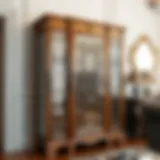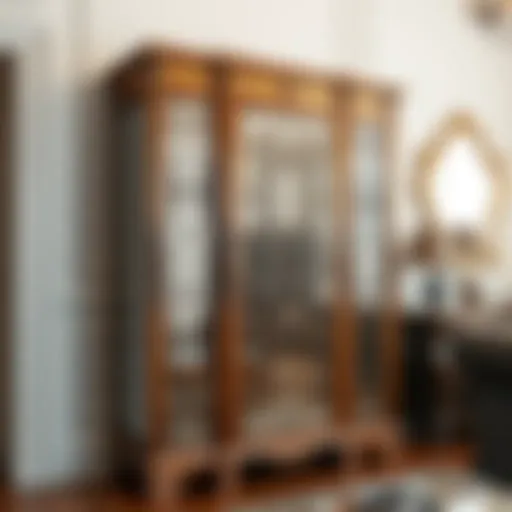Optimizing Children's Spaces with Nursery Cube Shelves
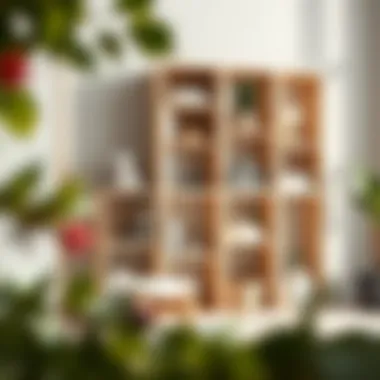

Intro
Creating a safe and inviting space for children is no small feat. When we think about nurseries, the first images that spring to mind are often whimsical colors, plush toys, and an atmosphere filled with warm laughter. Yet, amidst all this charm, there exists a fundamental need for practicality and structure. Enter nursery cube shelves: these sleek, functional pieces of furniture not only serve as eye-catching decor but also as essential tools for organization and safety.
Nursery cube shelves are a versatile option designed to meet the demands of active little hands and curious minds. Their modular design allows for a wide range of customizations, making them suitable for spaces with varied aesthetics, from minimalist environments to colorful, themed areas. This article sets out to explore how these shelves can elevate kids’ spaces, providing practical insights for homeowners, decorators, and DIY enthusiasts keen on crafting organised, stylish environments.
In our journey, we will traverse through popular furniture design styles that meld seamlessly with nursery cube shelves. We'll provide practical buying tips that guide you toward the perfect shelf selection tailored to your needs. Additionally, we will touch upon maintenance and care guidelines to ensure your investment stands the test of time.
By the end of this article, you will gain a thorough understanding not only of the functionality of nursery cube shelves but also of how they can be harmoniously integrated into your child’s living space. Let's dive deeper into the world of nursery cube shelves and discover their potential.
Prelims to Nursery Cube Shelves
The journey into designing a nursery often begins with the fundamental question of functionality and aesthetics. In this quest, nursery cube shelves stand out as indispensable tools. They are not just storage units; they play a pivotal role in crafting an organized, creative space for children. These shelves offer a blend of practicality and style, allowing for a seamless integration into varied designs. By focusing on nursery cube shelves, we highlight the fine balance between utility and decoration, ensuring that spaces are not only beautiful but also cater to the needs of growing children.
The benefits of nursery cube shelves are manifold. Firstly, they provide significant storage solutions that help in maintaining order amidst the typical chaos that accompanies children. Items ranging from toys to books can be easily sorted and accessed, reducing clutter and enabling children to learn organizational skills from a young age. Furthermore, these shelves are versatile, available in myriad designs, colors, and finishing options, making them suitable for any nursery theme.
In considering nursery cube shelves, it is vital to also reflect on the safety aspects. They are designed to be stable and secure, often incorporating features that minimize risks for children. Parents and designers alike must weigh the aesthetic value alongside these practical considerations.
Thus, as we delve deeper into the realms of nursery cube shelves, we will explore their conceptual essence, historical context, design versatility, storage solutions and more. This exploration promises to unveil a whole new perspective on how these shelves can redefine children’s spaces.
Understanding the Concept
When discussing nursery cube shelves, it's important to recognize their function as more than just furniture. These shelves are a multifaceted solution designed to cater to both storage and decorative needs. Essentially, a cube shelf is characterized by its modular structure, which allows for configuration in various setups. Parents can utilize the open compartments to display books, toys, and mementos, fostering an inviting atmosphere.
The modular nature of these shelves means they can be adapted over time. As a child grows, their interests inevitably change; the same applies to how spaces should transform accordingly. Cube shelves can be rearranged or expanded to accommodate new items or changing tastes, making them a wise investment for long-term use.
Additionally, these shelves can serve educational purposes. For example, organizing books by color or genre can encourage literacy and cognitive skills. In this light, the concept of nursery cube shelves merges fun with education, creating a dynamic environment conducive to growth.
Historical Perspective on Nursery Furniture
To fully appreciate the utility of nursery cube shelves, one must consider the evolution of nursery furniture in general. Historically, nursery furniture primarily prioritized function over form. In an era dominated by bulky cribs and massive wardrobes, parents often faced challenges in optimizing space.
However, the turn of the 21st century ushered in a shift towards more innovative designs. The rise of minimalist and Scandinavian influences emphasized clean lines and practicality. This has led to the development of cube shelves that are not only functional but also pleasing to the eye. They encapsulate the spirit of modern design—simple and effective.
A notable historical trend was the introduction of eco-friendly materials into furniture design. As awareness grew regarding sustainability, many manufacturers began integrating recycled or sustainably sourced materials into their products. This shift has significantly impacted the production of nursery furniture, aligning with a broader commitment to both safety and environmental wellness.
Design Versatility of Cube Shelves
The design versatility of cube shelves firmly establishes them as a cornerstone in nursery furniture. Their adaptability not only makes them functional but also allows them to fit seamlessly into a diverse array of aesthetics and spaces. In this section, we will unpack the critical elements of cube shelves—from varied styles to their capacity to meld with different nursery themes—showing how they enhance both organization and visual appeal.
Different Styles and Finishes
Cube shelves come in a cornucopia of styles and finishes, helping them cater to various design preferences. Whether your taste leans toward modern minimalism or rustic charm, there exists a cube shelf that aligns with your vision.
Here are some popular styles:
- Modern: Often characterized by clean lines and a sleek finish, modern cube shelves can be found in colors like white, black, or natural wood. They often incorporate materials like metal or glass, adding a contemporary flair to any nursery.
- Industrial: Combining wood and metal elements, industrial-style cube shelves embody a raw and edgy aesthetic that appeals to urban decorators looking for unique statements in their design.
- Vintage: These shelves might feature distressed wood or ornate detailing, exuding warmth and nostalgia, perfect for creating a cozy nursery atmosphere.
- Scandinavian: Known for their simplicity and functionality, Scandinavian cube shelves emphasize natural materials and soft hues, melding perfectly with a serene nursery palette.
As for finishes, the surface treatment plays a pivotal role in determining not just functionality but also child-friendliness:
- Non-toxic Paints: Safe for children's rooms, these finishes ensure that your little ones are shielded from harmful chemicals, offering peace of mind.
- Water-resistant Coatings: Spills and messes are part and parcel of child-rearing. Water-resistant finishes help maintain the integrity of the shelves, making clean-up a breeze.
It's worth noting that the variety in styles and finishes means these cube shelves can grow alongside your child. From nursery to teenage room, the adaptability ensures they remain a consistent part of the decor.
Adapting to Various Nursery Themes
Another significant aspect of cube shelves is their remarkable ability to adapt to different nursery themes. This feature enhances their role not only as storage solutions but also as integral design elements that reflect your child's personality and interests.
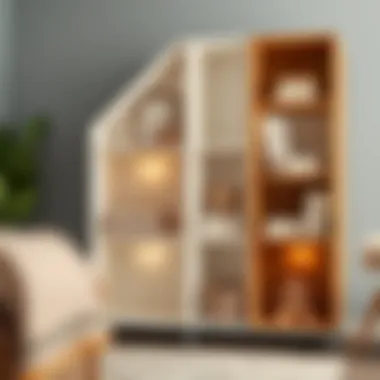

Here’s how cube shelves can complement a few popular nursery themes:
- Nature-Inspired: In a woodland-themed nursery, cube shelves made of natural wood can enhance the feeling of warmth. Incorporating plants or animal figurines into the shelves can further deepen the connection to nature.
- Under the Sea: Blue-toned cube shelves could mimic ocean depths and hold plush toys and books about marine life. Adding decorations like seashells or fish motifs can make for captivating displays.
- Space Adventure: For those looking to ignite curiosity and wonder, cube shelves painted in dark hues with twinkling lights and sci-fi artwork can transform a simple shelf into a portal for imagination.
- Artistic Playground: A whimsical approach with brightly colored cube shelves can accommodate creative tools like crayons, art supplies, and books, inspiring artistry and exploration in your child’s early years.
These adaptable shelves not only serve a practical purpose of organization but also help to create an engaging and stimulating environment for your little one. By considering the various styles and themes, parents can ensure that cube shelves not only satisfy storage needs but also enrich the overall design and experience of their child's room.
Storage Solutions in Nursery Cube Shelves
When it comes to designing a nursery, storage solutions play a pivotal role in maintaining not only the organization of the space but also its overall aesthetic appeal. Nursery cube shelves provide a standout answer to the increasingly prevalent problem of clutter in children’s spaces. With countless toys, books, and essentials, figuring out how to store them efficiently can become a real puzzle. Cube shelves, with their modular design, make it flexible to adjust storage to accommodate changing needs as children grow. Let’s dive deeper into the elements that emphasize storage efficiency and organization in these versatile pieces.
Maximizing Space Efficiency
Space is often at a premium in nurseries. This is where cube shelves shine brightly. Maximizing space efficiency doesn’t mean just cramming more items into tight spots; it's about smartly using every nook and cranny. These cube shelves often feature a variety of compartment sizes, allowing them to hold anything from plush toys to children's books. Here are some strategies to help maximize the potential of cube shelves:
- Vertical Stacking: Utilize the upward space by stacking multiple cube shelves to create an eye-catching structure that also serves to store more items.
- Mix and Match Sizes: By incorporating different cube sizes, you can create visual interest while accommodating various storage needs. Larger items can go into big cubes, while smaller toys or knick-knacks can occupy the smaller ones.
- Corner Spaces: Don’t overlook corners! Specialized cube shelves can fit snugly into corners, leading to effective storage without wasting any space.
The modularity of these shelves can even allow for reconfiguration over time as children progress from infancy to toddlerhood. Adapting the way you use these spaces can answer different storage needs like art supplies or board games later down the line.
Organizational Strategies
Creating an organized nursery isn’t just about having storage; it’s how you utilize that storage effectively. Organizational strategies within cube shelves can transform chaos into order in a matter of moments. Here are some savvy tactics:
- Labeling Systems: Consider labeling bins or cubes so little ones learn about organization. Color-coded or themed labels help children understand where things belong.
- Use Baskets and Bins: Soft bins or woven baskets can neatly stack in cube shelves. Not only does this soft approach add texture, but it also keeps clutter out of sight, keeping the nursery looking tidy.
- Rotate and Refresh: Every month or season, take time to refresh the items accessible on the shelves. Rotate toys and books, so children engage with different materials, encouraging imaginative play while keeping them organized.
Effective organization can lead to cultivating good habits in children for the future. Teaching them to put items back in their designated spaces sets a foundation for responsibility.
A well-organized nursery helps both parents and children feel more at ease. The effectiveness of cube shelves should not be underestimated, as they serve as both a practical storage solution and a means of teaching organization skills. Ultimately, incorporating storage solutions like nursery cube shelves can significantly enhance the functionality and harmony of children’s spaces.
Safety Considerations in Nursery Design
When designing a nursery, the safety of your child is paramount. Cube shelves, while versatile and functional, play a critical role in the layout and usability of these spaces. It’s imperative to take various safety considerations into account to ensure that both the furniture and the environment support your child's health and well-being.
Material Safety Standards
Choosing the right materials for nursery cube shelves is no small feat. One must prioritize products that comply with recognized safety standards. Here are some essential points to keep in mind:
- Non-toxic finishes: Any paint or varnish used should be free of harmful chemicals such as lead and phthalates. Opting for eco-friendly finishes not only protects your child but is kinder to the planet.
- Sturdy materials: Hardwood is generally more durable than softwood, meaning that it can endure a bit of roughhousing. Plywood and medium-density fiberboard (MDF) are also popular options, but they should adhere to stringent safety regulations.
- Certification: Look for products that have been certified by safety organizations such as the Consumer Product Safety Commission. This ensures that the items have undergone rigorous testing.
Avoiding harmful substances is key, as children are particularly susceptible to exposure. After all, any healthy environment is an investment in your child’s future. Aside from regulating your choice of materials, you must also consider the overall integrity of the structure you are placing in the nursery.
Secure Installation Practices
Once you have selected your cube shelves, it is essential to ensure that they are securely installed. This is where good craftsmanship and attention to detail come into play. Here are practical tips for safe installation:
- Wall anchoring: Using wall anchors can prevent the shelf from tipping over, especially as a toddler’s natural curiosity leads them to climb or pull on furniture.
- Avoid placing heavy items on the top shelf: Distributing weight evenly is crucial. Heavy items should be kept at lower levels where they are less likely to shift and cause accidents.
- Regular checks: Make it a habit to check the stability of the shelves periodically. Over time, screws may loosen or other issues may arise.
"A shelf may look secure at a glance, but it pays to be proactive—better safe than sorry!"
Ensuring a safe nursery goes beyond mere selection of furniture; it encompasses an entire philosophy about fostering a secure environment. Ultimately, children thrive best in spaces where they can explore freely while knowing that their wellbeing is a top priority.
Integration with Existing Furniture
When designing a nursery, integrating cube shelves with other furniture pieces creates a harmonious environment that balances functionality and style. This process doesn’t just make a room aesthetically pleasing; it ensures that everything works together cohesively. After all, the goal is to cultivate a space that not only looks good but is also useful for everyday life.
One major benefit of ensuring that nursery cube shelves match existing furniture is the visual continuity it offers. Whether you have a classic wooden crib or a sleek modern changing table, selecting shelves that reflect these styles can enhance the overall look of the room. For example, pairing white cube shelves with a white dresser helps maintain a clean line and smooth flow, making the nursery feel open and inviting. On the flip side, contrasting colors or finishes can create a focal point that draws the eye and adds personality to the space, as long as it doesn’t clash with the rest of the elements.
Moreover, size considerations play a pivotal role in this integration. Selecting shelves that are proportionate to other furniture can prevent any overcrowding or awkward spacing. When cube shelves are too large or too small in comparison to cribs or chairs, they can disrupt the room's balance. A well-planned nursery will allow for adequate movement and access to all furniture, promoting both safety and comfort.
If you consider the arrangement of items within the shelves as well, incorporating baskets or decorative boxes can further complement the room's design. These containers can be chosen to either match the color palette or introduce an accent hue that ties together various elements in the space.
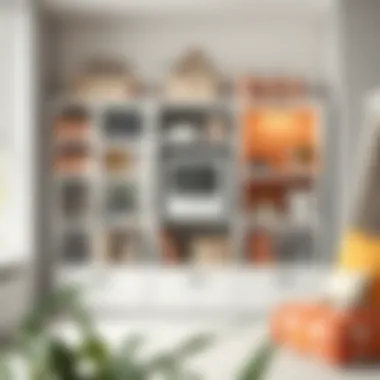

"A well-integrated nursery flows seamlessly, making daily activities like changing or feeding less of a chore and more a shared experience between parent and child."
In summary, effective integration of cube shelves with existing furniture is paramount. It leads to not only a visually appealing and organized nursery but also one that functions smoothly. Taking the time to orchestrate this relationship will pay dividends in comfort, utility, and style.
Complementary Pieces for Cohesive Design
To achieve true design cohesion in a nursery, it’s essential to incorporate complementary pieces alongside cube shelves. Think about how elements like a rocking chair, a side table, and even decorative items can resonate with the design of your storage solutions. Here are some key considerations:
- Finish and Material: Using the same finish or compatible materials for shelves and other furniture items can unify the room. For instance, if your cube shelves are made of natural wood, consider natural wood for your chair or changing table.
- Color Palette: Maintaining a consistent color scheme across furniture can establish a soothing atmosphere. If your cube shelves are painted a soft pastels shade, other pieces should reflect or complement this choice.
- Style: From farmhouse chic to minimalist modern, ensuring that furniture styles align can help create a well-rounded look. If your cube shelves have a modern design, pairing them with sleek, contemporary pieces can enhance that aesthetic.
Transitioning from Nursery to Toddler Room
Transitioning a nursery into a toddler room is more than just a change in decor; it’s a complete rethinking of how the space will function as your child grows. This is where cube shelves can really shine, serving as versatile elements that adapt to shifting needs.
As toddlers begin to play and explore independently, the utility of storage must transform as well. Cube shelves can be rearranged or repurposed to hold toys, books, and art supplies instead of just infant essentials. Additionally, encouraging independence can be facilitated by lowering shelf heights, making it easier for little ones to select their favorite toys themselves.
Amending the contents of the shelves can also play a significant role. Including a mix of educational toys and books alongside cherished plushies can foster an environment of learning. Consider giving sections of the shelves specific themes—for example, one cube for books, another for building blocks, and yet another for their art supplies. This thematic organization can help your child learn about putting things in their rightful place and developing their own sense of order.
Creative Decoration Ideas
Creative decoration ideas play a significant role in making a nursery feel like a special haven tailored for children. Cube shelves are not merely storage solutions; they serve as blank canvases waiting to be adorned with charming touches that reflect the child’s personality, interests, and the overall theme of the nursery. This section will explore ways to not just personalize cube shelves but also how to thoughtfully incorporate art and decor that nurtures creativity in a playful space.
Personalizing Cube Shelves
Personalizing cube shelves opens up a world of imaginative possibilities. It allows parents and caregivers to express a child’s unique character while also enhancing the visual appeal of the nursery. Here are some ways to inject a personal touch:
- Color Schemes: Consider painting the cube shelves in playful colors that resonate with the nursery theme or the child’s favorite hues. A bright yellow or soothing mint can transform an ordinary shelf into a striking focal point.
- Customized Storage Bins: Utilize tailored fabric bins or boxes for storage. Those can be personalized with the child’s name or initials, which not only helps with organization but also adds an endearing touch.
- Fun Shapes and Sizes: Rather than standard cubes, opt for uniquely shaped shelving units. Shelves with rounded edges or whimsical designs can spark curiosity and excitement.
The personalization of cube shelves isn't just about aesthetics; it's about creating a nurturing environment that makes children feel special and valued. Through items that hold meaning, each shelf can tell a story or convey a lesson, enriching the child's daily experiences.
Incorporating Artwork and Decorative Items
When it comes to creating an inviting nursery, integrating artwork and decorative items with cube shelves can enhance the atmosphere. This approach involves thoughtful curation of items that inspire positivity and creativity:
- Framed Artwork: Hang colorful framed pictures or illustrations on the wall above or near the cube shelves. Choose themes that resonate with childhood, such as animals, fairy tales, or nature scenes. Incorporating the child’s artwork can further personalize the space and help instill a sense of pride in their creativity.
- Books and Toys as Decor: Arrange beloved picture books and toys on the shelves as decorative elements. Positioning these items in appealing ways can inspire reading and play, making them part of the overall decor. A row of books with the covers facing outward acts as a vibrant display of colors.
- Seasonal Decorations: Change up decorations periodically to keep the space fresh and exciting. Simple seasonal items, be it autumn leaves, holiday ornaments, or summer-themed displays, can be interspersed among the regular decor to keep things lively.
"A nursery should be more than just functional; it should be a beautiful space that inspires growth and imagination."
By artfully blending personalization with decorative elements, cube shelves can transform from plain storage to striking artistic displays that enhance a child’s environment, fostering both creativity and comfort.
DIY Cube Shelf Projects
The surge in DIY projects reflects a deep desire for personalization in children’s spaces. When it comes to nursery cube shelves, embarking on a DIY journey not only gives you the chance to save some coin, but it also allows for a level of customization that ready-made products simply can’t provide. In creating your own cube shelf, you can match its design and color scheme to your existing nursery decor, thereby enhancing the overall aesthetic while meeting functional needs. This hands-on approach subsequently fosters a sense of accomplishment and creativity.
Step-by-Step Construction Guide
Creating your cube shelves can seem like a daunting task, but breaking it down into manageable steps makes it a breezy affair. Below is a simple guide you can follow:
- Gather Tools and Materials: You’ll need plywood, a saw, a drill, screws, and wood glue. Sandpaper for smoothing edges is also essential.
- Measure and Cut: Decide on the dimensions of your cube shelf. A common size is 12 inches by 12 inches for each cube. Measure carefully to ensure everything fits together snugly.
- Assemble the Cubbies: Start by constructing the cubes. Use wood glue and screws to secure the corners. Adding support brackets at the back strengthens the structure.
- Construct the Frame: Once the cubes are ready, connect them using additional pieces of wood that act as a frame. This will stabilize the shelf and help distribute weight evenly.
- Sand and Finish: Smooth out any rough edges with sandpaper. You might choose to paint or stain the shelves in a color that matches the nursery theme. Don’t forget to apply a protective finish like polyurethane to guard against wear and tear.
- Install: Secure your shelf to the wall using brackets to ensure it’s safe and sturdy, particularly in a child’s room.
Utilizing this guide is substantial for any DIY enthusiast. It demystifies the construction process, allowing you to take pride in your handiwork.
Tips for Customizing Your Shelves
Now that you have your cube shelf constructed, it’s time to think about how to make it truly your own. Here are several tips to add a personal touch:
- Color Coordination: Paint or stain the shelves to coordinate with your current nursery palette. Soft pastels or bright colors can evoke different moods.
- Baskets and Boxes: Consider using woven baskets or colorful boxes on the shelves. They not only organize toys and books but also add texture and dimension.
- Themed Decor: Incorporate items that reflect the nursery’s theme, like animal figurines for a safari theme or space ships for an astrophysical vibe.
- Labels: For older children, label the boxes or baskets. This not only aids in organization but also helps them learn to sort and categorize their belongings.
- Lighting: Use battery-operated lights inside the cube shelves for a cozy glow at bedtime.
In summary, DIY cube shelf projects offer both functional and aesthetic benefits for your nursery. They grant an opportunity to tailor the space to your unique preference while providing ample room for storage. With a bit of creativity and craftsmanship, your cube shelf could become a centerpiece of not just the room but your family's cherished memories.


Maintaining Cube Shelves
Maintaining cube shelves is crucial not just for preserving their physical integrity, but also for ensuring that they continue to serve their intended purpose effectively. Over time, everyday use can lead to wear and tear, dirt accumulation, and in some cases, safety issues. Regular maintenance practices ensure that these functional storage solutions remain visually appealing and safe for use in a child’s environment.
Cleaning and Care Tips
Keeping your nursery cube shelves in tip-top shape involves routine cleaning and basic care. Here are some essential tips:
- Dust Regularly: Use a microfiber cloth to dust both the surfaces and the corners of the shelves often. This prevents the buildup of allergens, making the space healthier for children.
- Use Gentle Cleaning Solutions: For a deeper clean, mix mild soap with warm water. Avoid harsh chemicals that could damage finishes or irritate sensitive skin.
- Avoid Excess Moisture: When cleaning, ensure that you don’t soak the shelves. Too much water can warp materials or cause mold to grow.
- Inspect Closures: If the shelves have doors or drawers, check that they open and close smoothly. Tight hinges may require a drop of oil to keep them functioning well.
Adopting these simple cleaning habits can prolong the life of your cube shelves while keeping them safe for little hands.
Periodic Inspection for Safety
Safety is a non-negotiable aspect of nursery design. To maintain your child’s environment, periodic inspections are essential. Consider the following practices:
- Inspect Stability: Regularly examine the shelves to see if they wobble or seem unstable. If they do, it’s crucial to check whether they are properly anchored to the wall, especially as children grow and may climb on them.
- Check for Damage: Look for any signs of damage, such as chipped edges or splintered wood. A sharp edge could pose a risk to curious toddlers.
- Verify Load Capacity: Ensure that the weight distributed across the shelves is appropriate. Overloading can not only bend the shelves but may also lead to more severe structural issues.
- Look for Hazards: Examine decorative items on the shelves. Ensure they are secured and aren’t made of materials that could be harmful if accidentally pulled down.
Keeping an eye on these safety measures ensures the nursery remains a haven for play and creativity rather than a source of worry.
By integrating regular cleaning and safety inspections into your maintenance routine, cube shelves will not only retain their charm but will also deliver a secure and organized environment for your little ones. Embracing these practices is essential for every designer, homeowner, or DIY enthusiast aiming to create an inviting children’s space.
Examining Trends in Nursery Furniture
When it comes to designing a nursery, many parents and decorators are eager to stay ahead of the curve. The trends in nursery furniture reveal much about how our understanding of children’s spaces has evolved. The trends influence not only the aesthetic appeal but also the functional aspects of a nursery. They help in creating a harmonious environment that nurtures growth and creativity while addressing practical needs.
This section peeks into the unfolding tapestry of modern nursery furniture, touching upon the important themes that shape its design. From showcasing the latest design movements to embracing sustainable choices, understanding these trends is pivotal for creating functional yet stylish spaces. With informed decisions, one can make the nursery a welcoming haven for children while making an impactful statement.
Current Design Movements
Today's nursery designs often reflect broader cultural shifts and values. The current design movements in nursery furniture emphasize minimalism, functionality, and personalization. Minimalism in nursery design, for instance, promotes a clutter-free environment. This isn't just about aesthetics; it's about creating a calming atmosphere for both the child and the caregiver.
Some prominent trends include:
- Scandinavian Influence: This trend prioritizes simplicity, clean lines, and natural materials, creating a light, airy feel in nurseries. Think light woods, soft pastels, and functional pieces that blend beauty with practicality.
- Mid-Century Modern: Characterized by retro aesthetics, this style draws from designs of the 1950s and 1960s. Pieces are often multi-functional, serving dual purposes which resonate with modern needs for space efficiency.
The focus on personalization also gains traction. Parents are increasingly interested in customizing their spaces with elements that reflect their personality and values. Custom shelves, artworks featuring family moments, and playful sculptures are all popular ways to make the nursery uniquely theirs.
Sustainability in Nursery Furniture Choices
In recent times, sustainability has moved to the forefront of many consumers' minds, and nursery furniture is no exception. Parents are keen on making choices that are not only good for their children but also for the planet. Sustainable practices are being woven into the design and manufacturing processes of nursery furniture, surprisingly transforming conventional norms.
When selecting furniture for a nursery, consider the following sustainable elements:
- Materials: Look for furniture made from responsibly sourced wood, organic textiles, and non-toxic finishes. Products labeled as certified eco-friendly can offer peace of mind for health-conscious parents.
- Longevity and Adaptability: Sustainable furniture choices are less about trends and more about durability. Pieces that can grow with the child or be adapted to different stages of life contribute to less waste overall.
- Second-Hand Options: Another emerging trend is embracing pre-loved furniture. Buying from thrift stores or swapping with other parents reduces the carbon footprint associated with new production.
"Sustainability isn't just a buzzword; it's a movement toward being responsible custodians of our resources for the next generation."
By keeping an eye on current trends and making informed decisions, parents can create nurseries that not only look good but also feel good—an environment where children can thrive and grow sustainably.
Epilogue
In this exploration of nursery cube shelves, we have seen how these seemingly simplistic structures play a pivotal role in transforming children's spaces into organized, functional areas. The importance of this topic cannot be overstated; as any designer or homeowner can testify, the arrangement and design of a nursery can significantly impact both functionality and aesthetics.
Recapping the Benefits of Cube Shelves
To sum up, cube shelves offer a multitude of benefits that work seamlessly together to create an ideal environment for children:
- Space optimization: The modular nature of cube shelves allows for maximizing storage in potentially limited spaces. Their design encourages vertical storage, enabling you to store more while maintaining a tidy appearance.
- Versatility in design: With a wide range of styles, colors, and finishes, cube shelves can complement various nursery themes. Whether your theme is whimsical or sophisticated, there's a cube shelf to match.
- Enhanced organization: These shelves enable an organized display of toys, books, and essentials, encouraging children to develop good habits by making it easy for them to access and return their items.
- Safety features: Many cube shelves are designed with rounded edges and sturdy materials, and with proper installation, the risk of accidents can be minimized, allowing mothers and fathers peace of mind.
- Aesthetic appeal: Cube shelves can serve as a blank canvas for personal expression, providing a space for decorative elements that reflect a child's personality or the parents' taste. From colorful bins to art supplies, the design possibilities are nearly endless.
Future Innovations in Nursery Storage Solutions
As we look to the future, it's evident that innovation in nursery storage will continue to evolve. Here are a few potential advancements:
- Smart technology integration: Imagine cube shelves that not only store items but also remember which toys are often used, notifying parents when it's time to rotate or clean.
- Eco-friendly materials: Sustainability in design has become a talking point among modern consumers. Future cube shelves may incorporate recycled materials or sustainably sourced woods, aligning with the growing emphasis on environmental responsibility.
- Customizable configurations: With increasingly modular designs, parents could tailor their shelves to fit their particular needs—easily adapting as children grow or their requirements change.
- Multi-functional designs: We're likely to see a rise in nursery furniture that doubles as storage and play areas, effectively merging fun and function.






